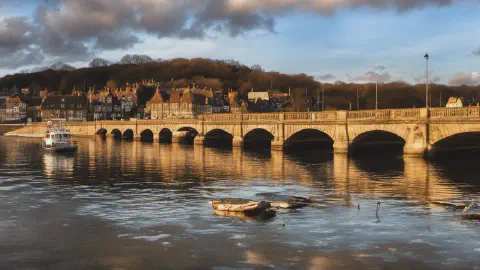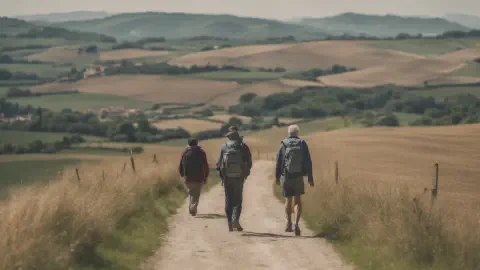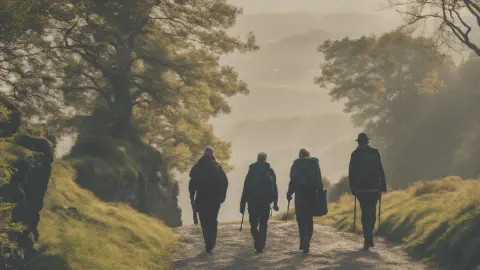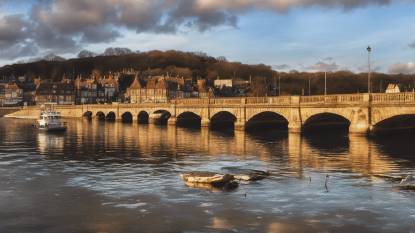
Camino Inglés: Neda to Pontedeume - Stage 2
Posted: | Updated:
Reading time: 9 minutes
Camino Inglés: Neda to Pontedeume - Stage 2
Posted: | Updated:
Reading time: 9 minutes
By: Simon Kemp, Editor
The Camino Inglés stage from Neda to Pontedeume, approximately 16km or 10 miles in length, unfolds a varied pilgrimage experience, blending urban, natural, and coastal landscapes. The journey begins in Neda, crosses the tranquil River Xubia, and encompasses a peaceful coastal path through Fene and Perbes, ultimately descending into the historical town of Pontedeume.
English Way, 2: Neda to Pontedeume. Camino de Santiago. Pilgrims navigate a modest uphill after the Xubia and a noticeable descent into Pontedeume, encountering a mix of terrains. Notable sites include Pontedeume’s rich historical district and the Tower of Andrade. Challenges encompass managing slight inclines and ensuring safe descent on potentially slippery slopes. Rest and refreshment opportunities are notably present in Fene and extensively in Pontedeume, the stage’s endpoint.
Map of Neda to Pontedeume
{{ google-maps-embed }}https://www.google.com/maps/embed?pb=!1m28!1m12!1m3!1d55112.63326276392!2d-8.215641856394415!3d43.45013703836513!2m3!1f0!2f0!3f0!3m2!1i1024!2i768!4f13.1!4m13!3e2!4m5!1s0xd2e756124abe817%3A0x17c852a4c302a961!2sNeda%2C%20A%20Coru%C3%B1a%2C%20Spain!3m2!1d43.4994218!2d-8.1579038!4m5!1s0xd2e7313842f5383%3A0x404f58273ca54b0!2sPontedeume%2C%20Spain!3m2!1d43.4074479!2d-8.1699094!5e0!3m2!1sen!2suk!4v1696776105712!5m2!1sen!2suk{{ /google-maps-embed }}
Starting point: Neda
Enveloped by the history and the gentle lapping of the Ría de Ferrol, Neda presents not just a stop but an experience for pilgrims on the Camino Inglés, offering a serene reflection of its Roman lineage and esteemed bread-making traditions. Ensconced on the Galician coast, Neda, with its welcoming populace, offers a perfect blend of natural vistas and a gentle brush with history, enticing pilgrims and tourists alike.
Neda Historical Background
- Neda through the Ages: A repository of tales and legends, Neda seamlessly melds its Roman history with its spiritual path, offering pilgrims a walk through its storied past en route to their spiritual journey.
- Legacy of Bread: The hearth of Neda has long been warmed by the tradition of bread-making, where ancient techniques breathe life into every loaf, symbolizing the town’s culinary and cultural richness.
Main Attractions & Points of Interest
Church of Santa María: Beyond its religious significance, the church serves as a historical pillar, intertwining tales of faith and architecture from epochs gone by.
Roman Bridge: The bridge, offering more than mere passage, stands as a testament to Neda’s ancient connectivity, binding tales of historical traverse with modern journeyers.
Belelle Waterfall: Surrounded by verdant expanses, it’s not just a natural marvel but a locus for tranquility and introspective moments amidst nature.
Accommodations: Neda provides warmth through its accommodations, from the simplistic yet comfortable Albergue de Peregrinos to homey guesthouses offering a glimpse into local life.
Culinary Offerings: Neda’s dining spots offer a palette of Galician flavours, where local produce and age-old recipes come together in a culinary symphony.
Local Customs & Traditions
- Celebrating Bread – Festa do Pan: Beyond mere celebration, the Festa do Pan is an embodiment of Neda’s heart and soul, where ovens are fired in unity and hands knead dough in rhythmic harmony, weaving together locals and visitors in a festive bond.
Natural Beauty & Surroundings
- Estuary’s Embrace: The ever-changing hues of the Ría de Ferrol, reflecting the sky above, offer a serene visual journey through Neda’s natural beauty.
- Belelle’s Whispers: The river threads through Neda, not just as a water body, but a storyteller of times and tales past, narrated through its gentle flow and the stoic presence of ancient mills.
Personal Experiences & Testimonials
- Reflective Voices: A pilgrim encapsulated their experience stating, “In Neda, every crumb of bread tells a story, every stone has a tale, and every step is a gentle traverse through both its physical beauty and the spiritual essence imbued in its pathways.”
Neda Practical Information
- Navigating to and through Neda: The accessibility of Neda via various modes of transport ensures pilgrims and travelers can seamlessly weave its experience into their journey, whether on foot or wheel.
- Seasonal Insights: Each season drapes Neda in a different cloak of experiences, be it the bustling joy of summer festivals or the tranquil aura of a spring morning.
Additional Resources & References
- Engaging with Neda’s Local Council for a deeper dive into its ongoing events and local offerings can enrich the exploratory experience.
- Exploring literature that envelops Neda’s culinary and historical journey allows for a pre-visit immersive understanding.

Detailed Breakdown of the Route
With its amalgamation of terrains, elevations, and points of interest, the Neda to Pontedeume stage offers a multifaceted experience, weaving through natural landscapes, coastal vistas, and culminating in the historical allure of Pontedeume.
1. Start in Neda:
Beginning in the quaint town of Neda, pilgrims might opt to explore local amenities before setting off. The initial path moves through urban surroundings, gradually unfolding into more natural, rural settings, offering a gentle start to the day’s walk.
2. Crossing the River Xubia:
This crossing is achieved via a bridge that not only serves as a practical passage but also offers lovely views of the river below. The flow of the River Xubia and the greenery of its banks provide a peaceful backdrop for pilgrims to contemplate as they traverse.
3. Fene and Perbes:
A serene part of the stage, the route through Fene and Perbes offers a balanced mix of minor roads and coastal paths. In Perbes, the Galician coastline is a highlight, providing panoramic views of the ocean and a fresh breeze for pilgrims.
4. Entry into Pontedeume:
Concluding this stage, the descent into Pontedeume introduces pilgrims to a charming town set at the Eume River’s mouth. Pontedeume’s cobbled streets and historical ambiance provide a delightful endpoint.
B. Changes in Terrain and Elevation:
The terrain and elevation on this stage are notably varied. After crossing the River Xubia, pilgrims encounter an uphill section, which, while not extremely steep, does require a steady pace. Subsequently, the terrain evens out before the downward slope into Pontedeume, providing a bit of a respite before another change in elevation.
Points of Interest Along the Route
1. Historical Sites:
- Pontedeume: The historical district is a blend of ancient stone buildings, narrow streets, and local culture.
2. Natural Features:
- River Xubia: The river, with its gentle flow and surrounding foliage, offers a natural escape early in the stage.
- Coastal Path through Perbes: An opportunity for pilgrims to relish unobstructed sea views and perhaps take a moment to reflect by the coast.
3. Local Landmarks:
- Tower of Andrade: This monument in Pontedeume is emblematic of local history and provides insight into the town’s past.
Potential Challenges or Difficulties
- Uphill Ascent: Post Xubia crossing, the incline may be slightly challenging for those with heavy packs or limited mobility.
- Descent to Pontedeume: The downhill section requires attentiveness to avoid mishaps, particularly in rainy or slippery conditions.
Opportunities for Rest Stops
- Fene: A viable spot for replenishment, with a few local cafes offering refreshments and light snacks.
- Pontedeume: With a variety of accommodations, eateries, and local shops, it allows pilgrims to rest and refuel adequately before the next stage of the journey.
- Get a good rest before you venture onto the next stage of the Camino Inglés from Pontedeume to Betanzos
Public Transportation Options:
There are several options for traveling from Neda to Pontedeume in Spain using public transportation:
- Train: Renfe Viajeros operates a train from Neda to Puentedeume once daily. The journey takes approximately 14 minutes and tickets cost between €3 – €6.
- Bus: MonBus operates a bus from Neda to Pontedeume twice daily. The journey takes around 33 minutes and tickets cost between €1 – €4.
- Taxi: You can also take a taxi from Neda to Pontedeume. The ride would take about 10 minutes and cost between €19 – €24.
- Driving: If you have access to a car, you can drive from Neda to Pontedeume in about 10 minutes. The fuel cost would be between €2 – €4.
Please note that these are estimated costs and travel times, and they may vary depending on the time of day and other factors. For more detailed information, you can check out the step-by-step directions and compare ticket prices and travel times on Rome2Rio’s travel planner.

Destination: Pontedeume
The quaint town of Pontedeume, set against the backdrop of verdant hills and caressed by the gentle flow of the Eume River, entices visitors with its medieval architecture, vibrant local life, and the serene landscapes of Galicia. Positioned strategically on the Camino Inglés between Ferrol and A Coruña, Pontedeume offers a peaceful and picturesque stopover for pilgrims, allowing them to unwind and explore.
Pontedeume History
- Medieval Resonance: Pontedeume’s historical blend is rich, woven with tales from medieval times, particularly those surrounding the Andrade family, whose 14th-century tower still presides over the town with a silent yet formidable presence.
- The Ancient Bridge: The medieval bridge of Pontedeume, though now with fewer arches than its original structure, connects not only shores but also epochs, enabling pilgrims to traverse paths laden with history.
Pontedeume Key Attractions
- Torreón de los Andrade: Standing proudly amidst the town, this tower is a tangible connection to the noble Andrade family and the medieval history of Pontedeume, providing both visual and historical allure.
- Fragas do Eume: A sprawling natural park, it envelopes visitors in a lush, biodiverse environment, offering pathways through dense forests, alongside the soothing sounds of the Eume River, and into nature’s untouched sanctuary.
Pontedeume Services for Pilgrims
- Accommodation Options: From the welcoming Albergue-Pensión As Hortas to small, family-operated pensions, Pontedeume provides a range of accommodation options, ensuring comfort and warmth for weary travelers.
- Culinary Journey: Be it in cozy cafés or vibrant tapas bars, Pontedeume’s culinary scene offers a delightful exploration of Galician cuisine, with fresh seafood and local produce being notable highlights.
Pontedeume Culture
- Feira Medieval: A splendid affair, the annual medieval fair engulfs the town in a vibrant spectacle of traditional crafts, ancient trade simulations, lively performances, and a heartfelt celebration of its rich historical and cultural heritage.
Surrounding Natural Beauty
- Pristine Beaches: Beyond the hushed whispers of the forest, Pontedeume unravels into pristine beaches, offering a juxtaposition of tranquility and vivacity where the land meets the Atlantic.
- Exploratory Trails: Pontedeume’s nature trails, from gentle river walks to adventurous forest treks, beckon explorers to lose themselves amidst its natural tableau.
Pilgrim Testimonials
- Reflective Voices: “Pontedeume, with its ancient stones, rich greenery, and gentle river, whispered tales of times gone by, offering a meditative pause in our pilgrim journey,” reflects a pilgrim, underscoring the town’s capacity to enchant and captivate.
Pontedeume Practical Information
- Getting There: Be it by car, bus, or on foot, Pontedeume’s strategic location and well-connected transport options ensure ease of access for pilgrims and other visitors.
- When to Explore: The vibrant hues of summer festivities may attract many, yet the gentle embrace of spring and fall unveils Pontedeume’s tranquil charm and natural beauty in a more serene ambiance.
Further Resources
- Local Guidance: The Pontedeume tourist office, with its wealth of local knowledge, helps visitors delve deeper into the town’s offerings, ensuring a thorough and enriching exploration.
- Camino Guides: Utilizing guides and resources like “A Pilgrim’s Guide to the Camino Inglés” can provide additional, detailed insights for those venturing on the pilgrimage.
Pontedeume, with its intertwining trails of history, culture, and nature, offers a beautifully interwoven blend of experiences, ensuring every visitor, especially pilgrims on the Camino Inglés, carves memories that echo the town’s rich and timeless spirit.

